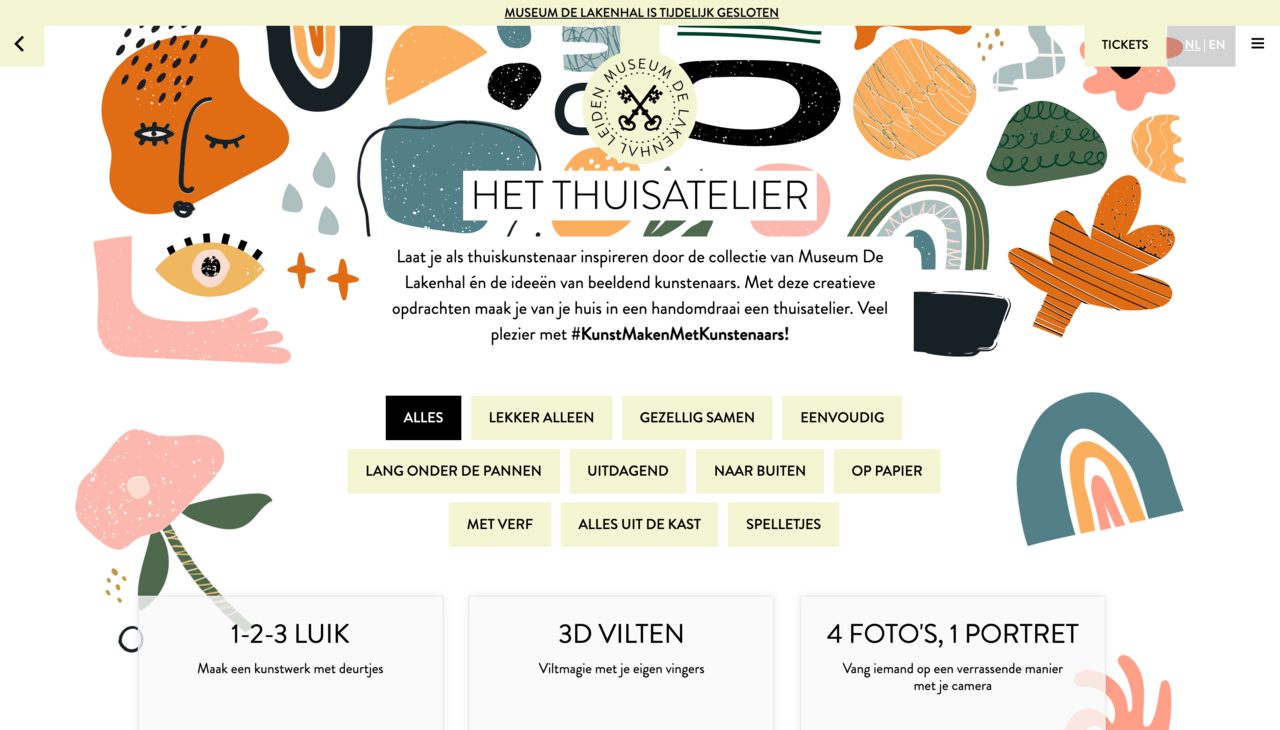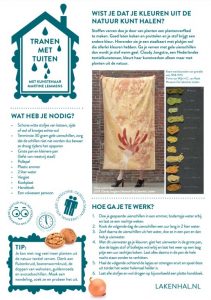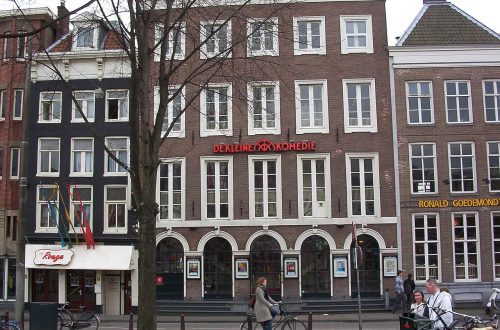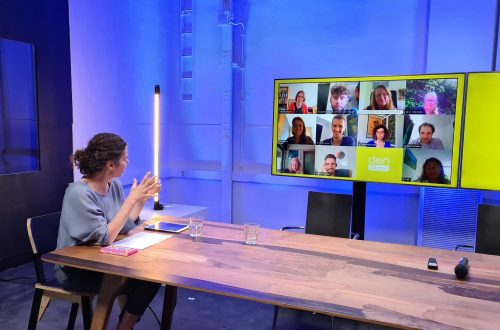
Creating art at home (Leiden, the Netherlands)
Museum De Lakenhal’s developed assignments to develop your creativity in your own environment in its “thuisatelier’. This allowed the museum to continue to inspire visitors and contribute to its goal of personal development online. This case is appealing because of its involvement of real artists who think out the assignments, its attractive design, and its real fun, and easy to carry out creative assignments. It was mainly very attractive for parents with no special artistic material at their disposal during the lock-down. It could be learned that one does not always need expensive artistic material to get creative, making the threshold for starting on a creative project at home much lower.
Background
Museum De Lakenhal was established as an initiative of the citizens of the city Leiden in 1874 and is located in the monumental building Laecken-Halle from 1640, which used to be at the core of Leiden’s famous textile industry. The Lakenhal is a museum for visual arts, crafts, and history in Leiden. During the last renovation from 2016-2019, the museum was restored and expanded with modern architecture. The museum‘s goal is to connect past and present by inspiring visitors with old and new viewpoints. (Museum De Lakenhal 2021)
Museum De Lakenhal has an educational character and is also mainly aimed at families, children, and families through the Kunst atelier. They also have programs for visitors with disabilities. For example, they use Dutch sign language in guided tours. Because of the educational and creative character through the workshops in the Kunst atelier, they maintain contacts with artists who are also asked to assist during the workshops. Because of the educational character, they maintain a lot of contact with schools from primary and secondary education but also with secondary education (Heesbeen- de Vos 2022).
The target group of the home studio is mainly families because the assignments are very focused on fun activities to do as a family during the lockdown. However, the home studio is suitable for everyone from 6 to 96, everyone who likes to participate is welcome. They would also like to bring education more into this so that teachers can apply these creative ideas during homeschooling.
Since the foundation of Museum De Lakenhal, donations and subsidies have been essential for the development of the collection and the building. The museum cannot do without the support of governments, funds, partners, patrons, friends, and private individuals (Museum De Lakenhal 2022).
Description
 Regular activity of Museum De Lakenhal was the open studio on Sundays. Each season you will work with different materials or a different technique under the guidance of a workshop teacher, who is also an artist himself. The goal of the workshop is to discover your own creative talent.
Regular activity of Museum De Lakenhal was the open studio on Sundays. Each season you will work with different materials or a different technique under the guidance of a workshop teacher, who is also an artist himself. The goal of the workshop is to discover your own creative talent.
Due to the lockdown, families with children were stuck at home and suddenly education had to be given at home. The museum thought it could respond well to this by moving the open studio to an online program. The concept of the open studio is to get acquainted with creative technology in an accessible way trying to use the own kitchen table and materials that everyone has at home (Heesbeen- de Vos 2022).
The difference between the open studio and the home studio is that the museum has materials at its disposal that you often do not have at home. For the home studio, it was therefore chosen to work with materials that people generally have at home. The assignments can be made together as a family or just alone (Heesbeen- de Vos 2022). Assignments include; making a family quartet game, recreating Theo van Doesburg’s Contra Composition VII on your sandwich (or pizza, or pancake), recreating a fossile for future archeologists and much, much more.
Every month a new assignment, inspired by the museum’s collection, and thought out by an artist, is added to the home studio. Because of the already existing contacts with artists that were giving lessons in the physical studio the museum already had for the art classes, this was very easy to organize.
On the main webpage all assignments are placed in windows with clear titles and categories, and if you click on one of them, a printable assignment page in pdf format will appear with clear step by step instructions.
The assignments are divided into different categories such as; alone, together, easy, challenging, and more. These were created to make it easier to see what kind of assignments there are and will suit the person or situation in question. In this way it is also good to use for the younger children because parents can quickly assess what level the assignment is, and assist their child accordingly (Heesbeen- de Vos 2022).
Impact
 An open studio emerged with the emphasis on low-threshold assignments in which you get acquainted with another creative technique and which you can carry out from your own kitchen table with material available in most homes (such as sandwiches) was a relief for parents who sat at home with children and with no possibility of going out to buy handcraft material due to the closure of shops (Heesbeen- de Vos 2022).
An open studio emerged with the emphasis on low-threshold assignments in which you get acquainted with another creative technique and which you can carry out from your own kitchen table with material available in most homes (such as sandwiches) was a relief for parents who sat at home with children and with no possibility of going out to buy handcraft material due to the closure of shops (Heesbeen- de Vos 2022).
The most important lesson learned for the museum is that they have made the decision that they will create both offline and online possibilities whenever creating new activities. This time beforehand and with greater attention to the whole infrastructure involved. Now, they have both an offline and an online creative workshop, and they will look to expand this ‘hybrid’ programming.
This case is attractive because of its involvement of real artists who think out the assignments, its attractive design, and its real fun, creative easy to carry out assignments. In terms of publicity it has received less attention than other similar initiatives as a quick scan of the museum’s social media channels suggest. Somehow, the results of the assignments were not shared as massively as other similar initiatives that were more widely shared on social media. The museum agrees that this was not yet on top of their mind when they were creating the Thuisatelier, but will become more top of mind in future.
The Thuisatelier, however, did create traffic and in this way ensured that visitors remained connected to the museum even if it did not generate income for them. Therefore, since corona, more attention has been given to the museum’s donors and members of its association. The webpage dedicated to members has expanded, for instance, in an effort to get them more involved.
The online home studio will continue to exist after the closure and Corona, but, according to the museum, the core business is a museum that is open and where visitors can physically admire the exhibition (Heesbeen- de Vos 2022).
Interpretation
When the home studio was set up, the museum had in mind that it should become a sustainable initiative that was not only used as a filling but would become a long-term part of the museum. The museum is also looking how they can ensure that in the future there is an infrastructure that makes it easier for the museum to offer a digital product next to the physical ones (Heesbeen- de Vos 2022). Since the output of the home-artists was as not widely shared as other similar initiatives, and therefore less visible in the media, the next step could be to research how other initiatives have created more interaction.
References
- Been- de Vos, Anouk, interview by Dominique Schut. 2022. (January 11).
- Museum De Lakenhal. 2021. Het gebouw. Accessed January 2022. https://www.lakenhal.nl/nl/verhaal/het-gebouw. (Accessed 22 January 2022)
- —. 2020. Het thuisatelier. Geopend January 2022. https://www.lakenhal.nl/nl/thuisatelier. (Accessed 22 January 2022)
- —. 2022. Met dank aan onze begunstigers. Geopend January 2022. https://www.lakenhal.nl/nl/verhaal/met-dank-aan. (Accessed 22 January 2022)
- —. 2021. Missie en Visie. Accessed January 2022. https://www.lakenhal.nl/nl/verhaal/missie-en-visie. (Accessed 22 January 2022)
Author
- Dominique Schut, student at Inholland University of Applied Sciences
Header photograph
Wikimedia Commons




